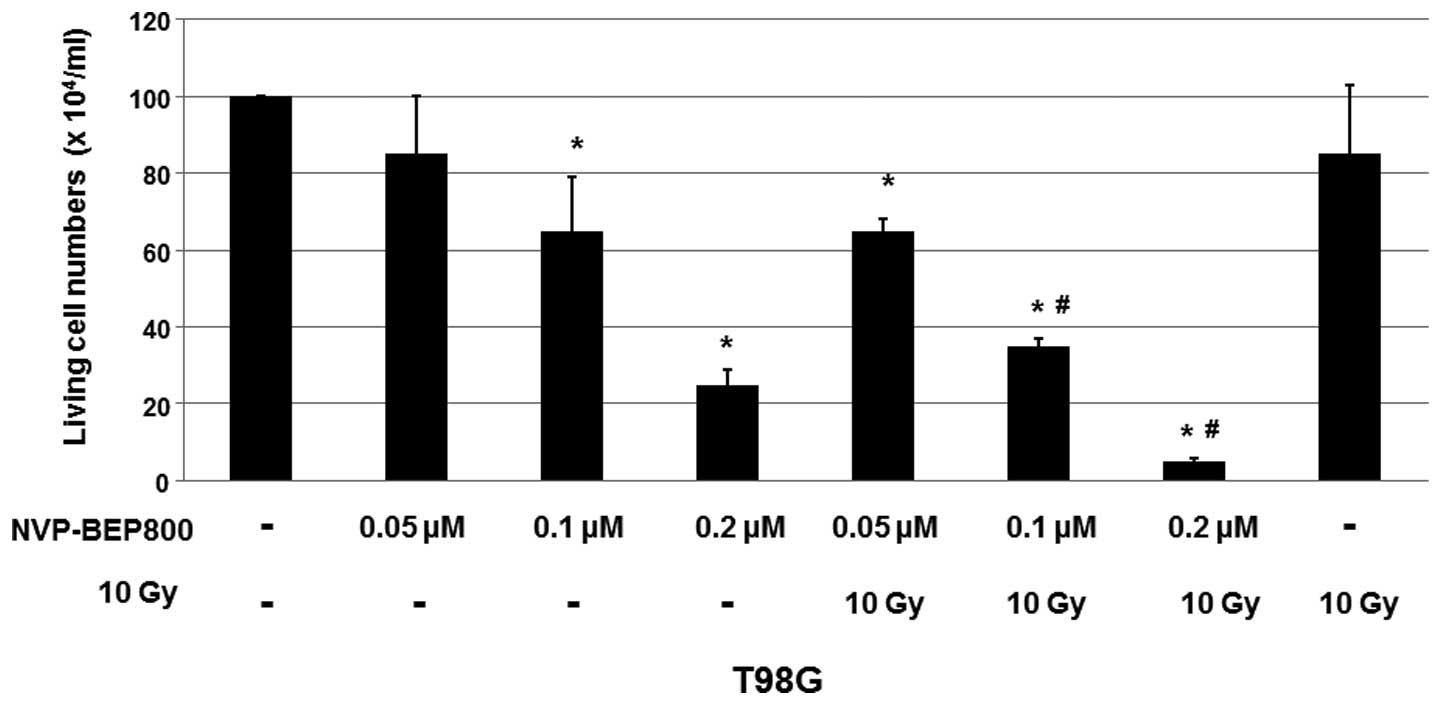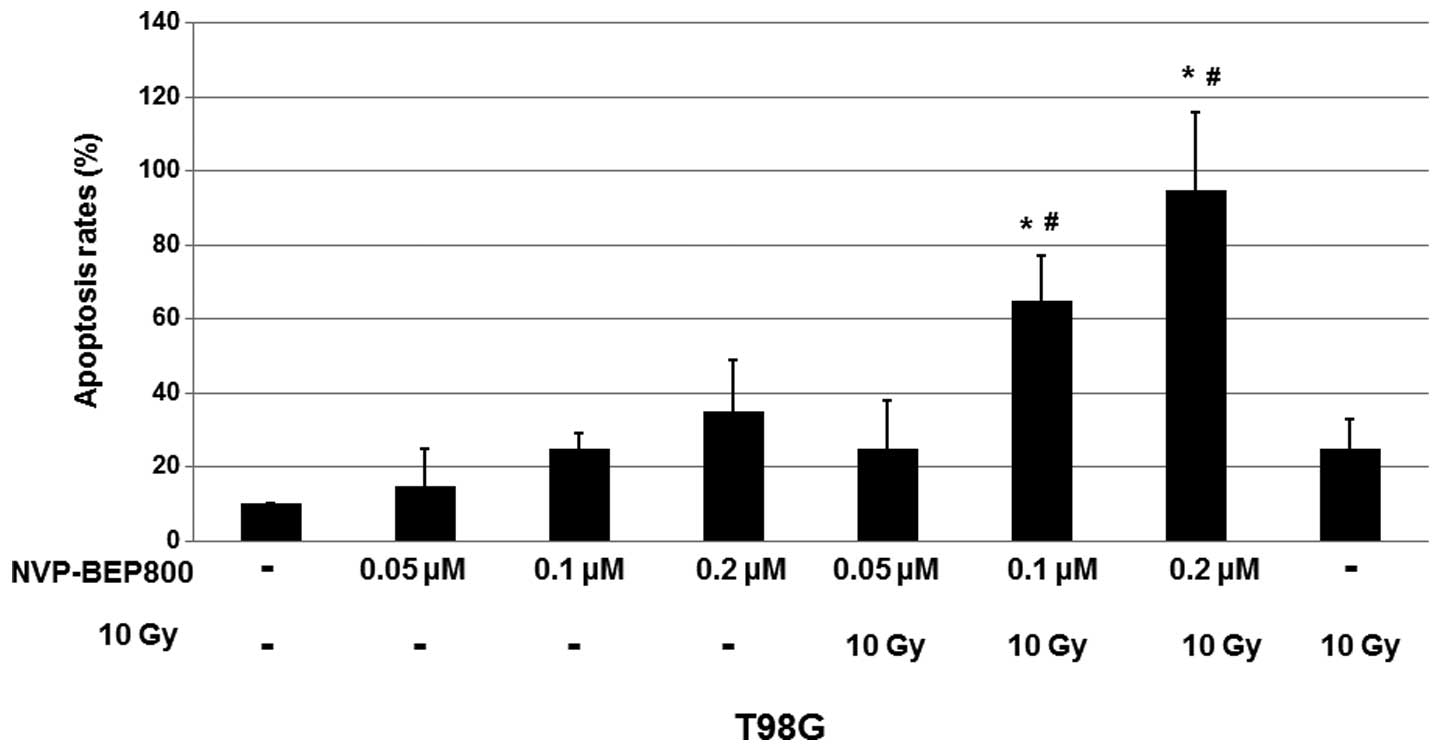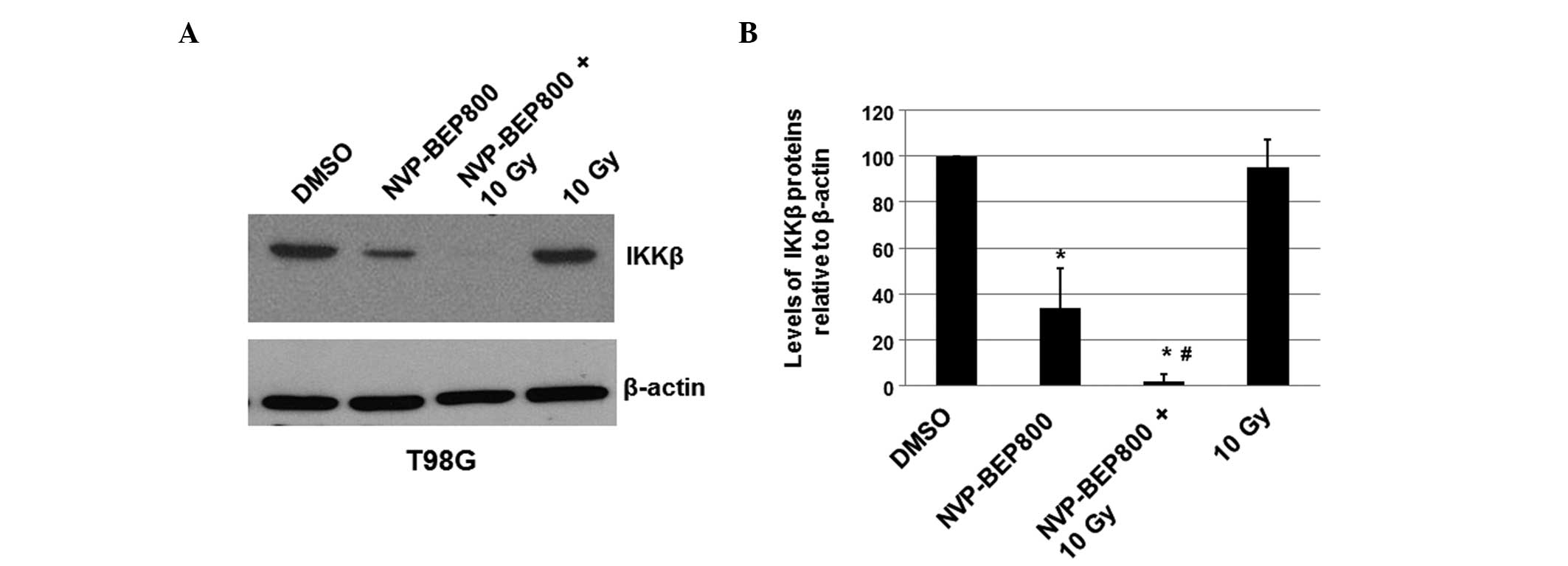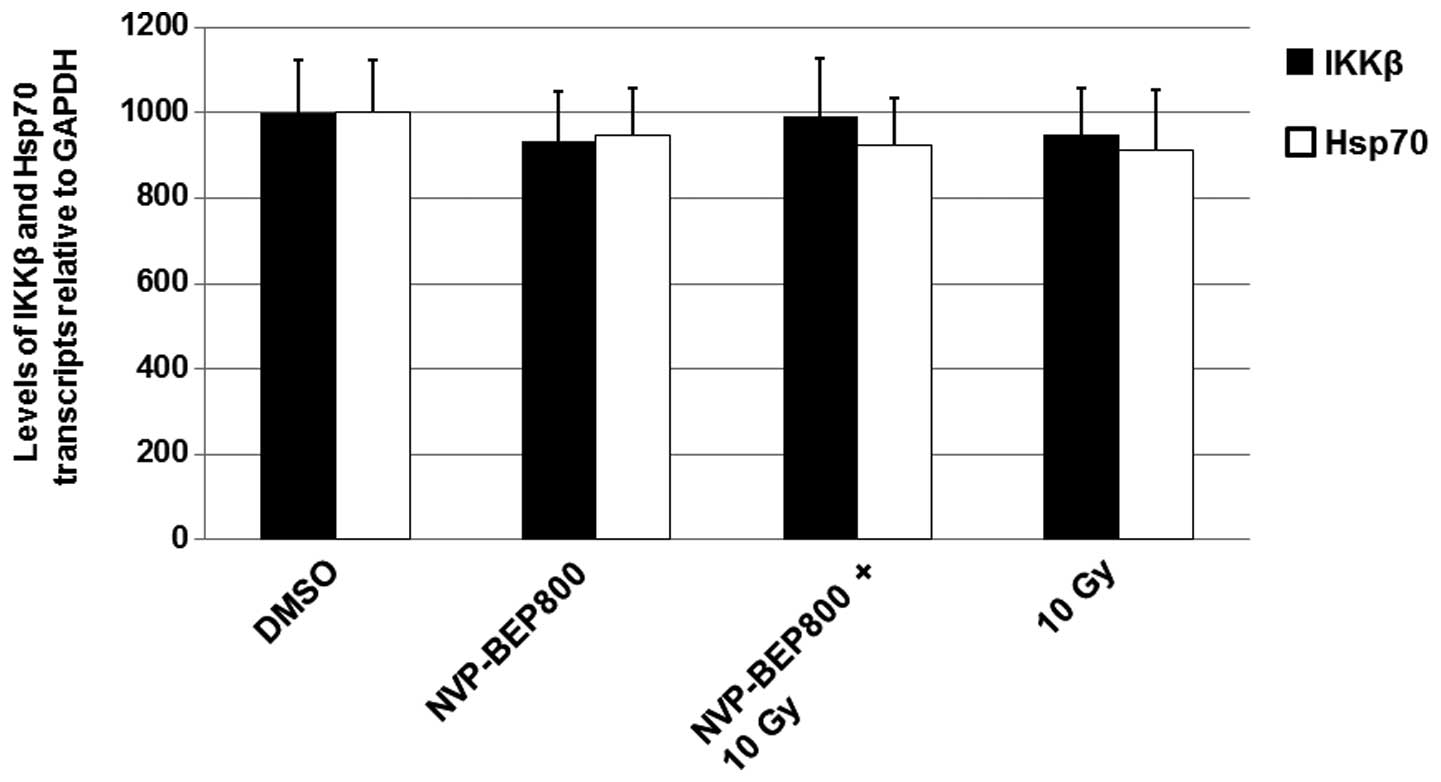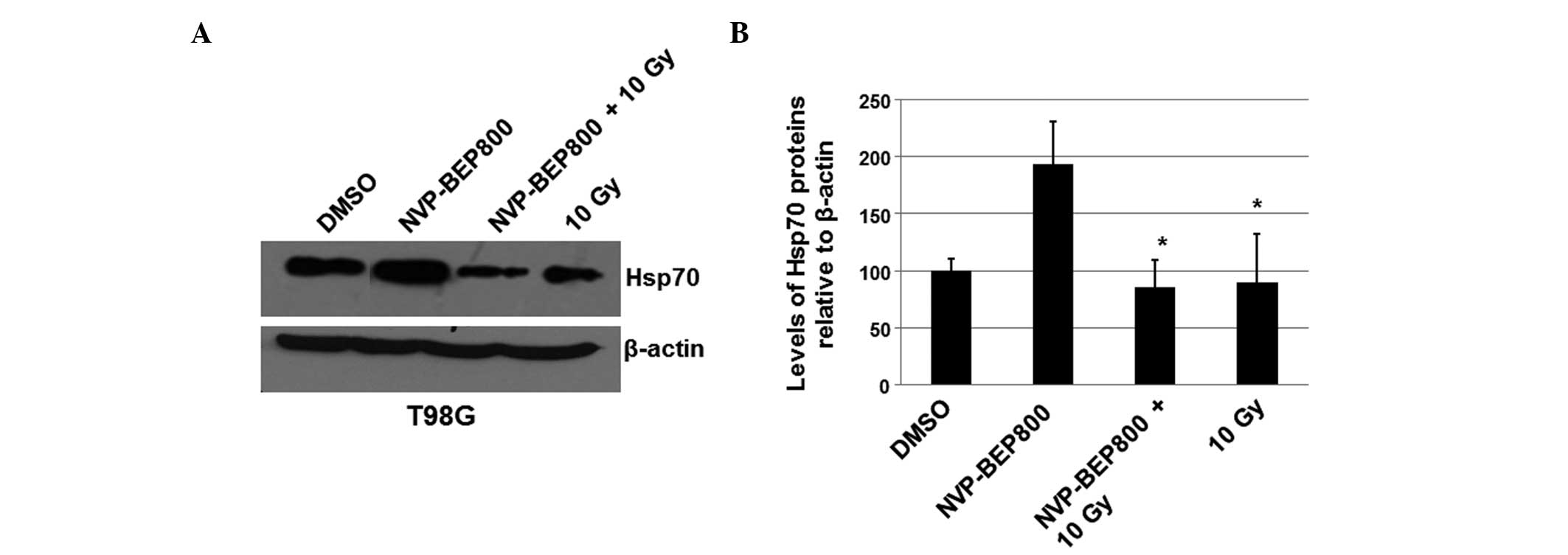|
1
|
Thomas L, Di Stefano AL and Ducray F:
Predictive biomarkers in adult gliomas: the present and the future.
Curr Opin Oncol. 25:689–694. 2013. View Article : Google Scholar : PubMed/NCBI
|
|
2
|
Thon N, Kreth S and Kreth FW: Personalized
treatment strategies in glioblastoma: MGMT promoter methylation
status. Onco Targets Ther. 6:1363–1372. 2013. View Article : Google Scholar : PubMed/NCBI
|
|
3
|
Chowdhary S and Chamberlain M: Bevacizumab
for the treatment of glioblastoma. Expert Rev Neurother.
13:937–949. 2013. View Article : Google Scholar : PubMed/NCBI
|
|
4
|
Tejada S, Aldave G, Marigil M, Gállego
Pérez-Larraya J, Domínguez PD and Díez-Valle R: Factors associated
with a higher rate of distant failure after primary treatment for
glioblastoma. J Neurooncol. 116:169–175. 2014. View Article : Google Scholar : PubMed/NCBI
|
|
5
|
Gaber M, Selim H and El-Nahas T:
Prospective study evaluating the radiosensitizing effect of reduced
doses of temozolomide in the treatment of Egyptian patients with
glioblastoma multiforme. Cancer Manag Res. 5:349–356. 2013.
|
|
6
|
Niyazi M, Schwarz SB, Suchorska B and
Belka C: Radiotherapy with and without temozolomide in elderly
patients with glioblastoma. Strahlenther Onkol. 188:154–159. 2012.
View Article : Google Scholar : PubMed/NCBI
|
|
7
|
Matsumoto H, Hirabayashi Y, Kubota H, et
al: A combined therapy with docetaxel and nedaplatin for relapsed
and metastatic esophageal carcinoma. Anticancer Res. 32:1827–1831.
2012.PubMed/NCBI
|
|
8
|
Jingu K, Ariga H, Nemoto K, et al:
Long-term results of radiochemotherapy for solitary lymph node
metastasis after curative resection of esophageal cancer. Int J
Radiat Oncol Biol Phys. 83:172–177. 2012. View Article : Google Scholar
|
|
9
|
Zhu H, Huo X, Chen L, Wang H and Yu H:
Clinical experience with radio-, chemo- and hyperthermotherapy
combined trimodality on locally advanced esophageal cancer. Mol
Clin Oncol. 1:1009–1012. 2013.PubMed/NCBI
|
|
10
|
Jolly C and Morimoto RI: Role of the heat
shock response and molecular chaperones in oncogenesis and cell
death. J Natl Cancer Inst. 92:1564–1572. 2000. View Article : Google Scholar : PubMed/NCBI
|
|
11
|
Rérole AL, Jego G and Garrido C: Hsp70:
anti-apoptotic and tumorigenic protein. Methods Mol Biol.
787:205–230. 2011.PubMed/NCBI
|
|
12
|
Picard D: Heat-shock protein 90, a
chaperone for folding and regulation. Cell Mol Life Sci.
59:1640–1648. 2002. View Article : Google Scholar : PubMed/NCBI
|
|
13
|
Whitesell L and Lindquist SL: HSP90 and
the chaperoning of cancer. Nat Rev Cancer. 5:761–772. 2005.
View Article : Google Scholar : PubMed/NCBI
|
|
14
|
Neckers L and Neckers K: Heat-shock
protein 90 inhibitors as novel cancer chemotherapeutic agents.
Expert Opin Emerg Drugs. 7:277–288. 2002. View Article : Google Scholar : PubMed/NCBI
|
|
15
|
Defee MR, Qin Z, Dai L, Toole BP, Isaacs
JS and Parsons CH: Extracellular Hsp90 serves as a co-factor for
NF-κB activation and cellular pathogenesis induced by an oncogenic
herpesvirus. Am J Cancer Res. 1:687–700. 2011.PubMed/NCBI
|
|
16
|
Bandyopadhyay S, Chiang CY, Srivastava J,
et al: A human MAP kinase interactome. Nat Methods. 7:801–805.
2010. View Article : Google Scholar : PubMed/NCBI
|
|
17
|
Yang J, Lin Y, Guo Z, et al: The essential
role of MEKK3 in TNF-induced NFκB activation. Nat Immunol.
2:620–624. 2001.PubMed/NCBI
|
|
18
|
Wu MX, Ao Z, Prasad KV, Wu R and
Schlossman SF: IEX-1L, an apoptosis inhibitor involved in
NF-κB-mediated cell survival. Science. 281:998–1001. 1998.
|
|
19
|
Bull EE, Dote H, Brady KJ, et al: Enhanced
tumor cell radiosensitivity and abrogation of G2 and S phase arrest
by the Hsp90 inhibitor
17-(dimethylaminoethylamino)-17-demethoxygeldanamycin. Clin Cancer
Res. 10:8077–8084. 2004. View Article : Google Scholar : PubMed/NCBI
|
|
20
|
Sato S, Fujita N and Tsuruo T: Modulation
of Akt kinase activity by binding to Hsp90. Proc Natl Acad Sci USA.
97:10832–10837. 2000. View Article : Google Scholar : PubMed/NCBI
|
|
21
|
Schulte TW, Blagosklonny MV, Ingui C and
Neckers L: Disruption of the Raf-1-Hsp90 molecular complex results
in destabilization of Raf-1 and loss of Raf-1-Ras association. J
Biol Chem. 270:24585–24588. 1995. View Article : Google Scholar : PubMed/NCBI
|
|
22
|
Ivanov VN and Hei TK: A role for
TRAIL/TRAIL-R2 in radiation-induced apoptosis and radiation-induced
bystander response of human neural stem cells. Apoptosis.
19:399–413. 2014. View Article : Google Scholar : PubMed/NCBI
|
|
23
|
Carr SD, Green VL, Stafford ND and
Greenman J: Analysis of radiation-induced cell death in head and
neck squamous cell carcinoma and rat liver maintained in
microfluidic devices. Otolaryngol Head Neck Surg. 150:73–80. 2014.
View Article : Google Scholar : PubMed/NCBI
|
|
24
|
Ballarini F, Altieri S, Bortolussi S,
Giroletti E and Protti N: A model of radiation-induced cell
killing: insights into mechanisms and applications for hadron
therapy. Radiat Res. 180:307–315. 2013. View Article : Google Scholar : PubMed/NCBI
|
|
25
|
Bao XH, Takaoka M, Hao HF, et al:
Antiproliferative effect of the HSP90 inhibitor NVP-AUY922 is
determined by the expression of PTEN in esophageal cancer. Oncol
Rep. 29:45–50. 2013.PubMed/NCBI
|
|
26
|
Grem JL, Morrison G, Guo XD, et al: Phase
I and pharmacologic study of
17-(allylamino)-17-demethoxygeldanamycin in adult patients with
solid tumors. J Clin Oncol. 23:1885–1893. 2005. View Article : Google Scholar : PubMed/NCBI
|
|
27
|
Guo F, Rocha K, Bali P, et al: Abrogation
of heat shock protein 70 induction as a strategy to increase
antileukemia activity of heat shock protein 90 inhibitor
17-allylamino-demethoxy geldanamycin. Cancer Res. 65:10536–10544.
2005. View Article : Google Scholar : PubMed/NCBI
|
|
28
|
Brough PA, Barril X, Borgognoni J, et al:
Combining hit identification strategies: fragment-based and in
silico approaches to orally active 2-aminothieno[2,3-d]pyrimidine
inhibitors of the Hsp90 molecular chaperone. J Med Chem.
52:4794–4809. 2009.PubMed/NCBI
|
|
29
|
Massey AJ, Schoepfer J, Brough PA, et al:
Preclinical antitumor activity of the orally available heat shock
protein 90 inhibitor NVP-BEP800. Mol Cancer Ther. 9:906–919. 2010.
View Article : Google Scholar : PubMed/NCBI
|
|
30
|
Stühmer T, Chatterjee M, Grella E, et al:
Anti-myeloma activity of the novel 2-aminothienopyrimidine Hsp90
inhibitor NVP-BEP800. Br J Haematol. 147:319–327. 2009.PubMed/NCBI
|
|
31
|
Niewidok N, Wack LJ, Schiessl S, et al:
Hsp90 inhibitors NVP-AUY922 and NVP-BEP800 may exert a significant
radiosensitization on tumor cells along with a cell type-specific
cytotoxicity. Transl Oncol. 5:356–369. 2012. View Article : Google Scholar
|
|
32
|
Stingl L, Stühmer T, Chatterjee M, Jensen
MR, Flentje M and Djuzenova CS: Novel HSP90 inhibitors, NVP-AUY922
and NVP-BEP800, radiosensitise tumour cells through cell-cycle
impairment, increased DNA damage and repair protraction. Br J
Cancer. 102:1578–1591. 2010. View Article : Google Scholar : PubMed/NCBI
|



